This Wednesday, March 27, Donna Cooper and I led Wednesday Morning Birding inland to see the spectacle of ducks along Scotland Road in Newbury. We found the pools at the Common Pasture full of excited Green-winged Teals, with resplendent males busily vying for attention. A drake Northern Shoveler was snoozing when we arrived, but he woke to join his female in the parade. Even a pair of American Black Ducks got in the spirit, all of them looking fabulous in the bright sun, which doubly highlighted the many hues of the ducks as it reflected off the smooth pools. A flock of eight Killdeers made a brief appearance on the meadow, and the air was filled with early spring birdsong. The show there will continue through this month. We await appearances by uncommon species such as Blue-winged Teal, Eurasian Wigeon, or perhaps a Sandhill Crane if we are lucky.
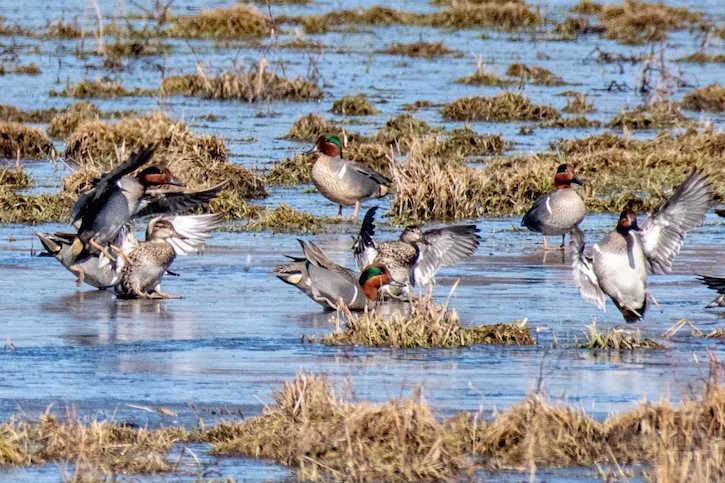
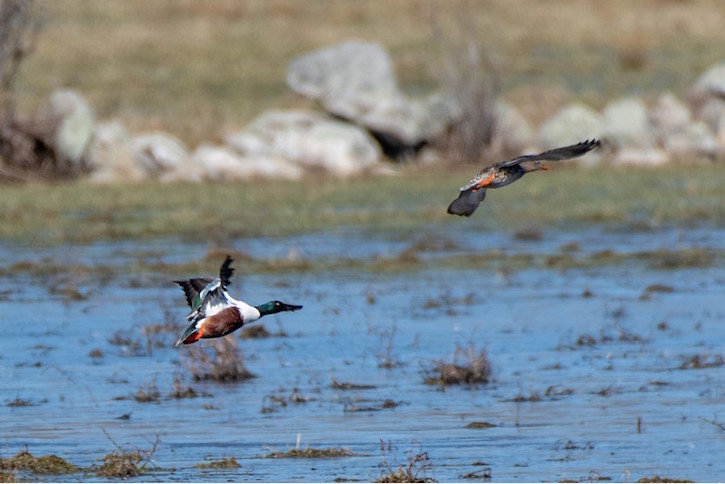
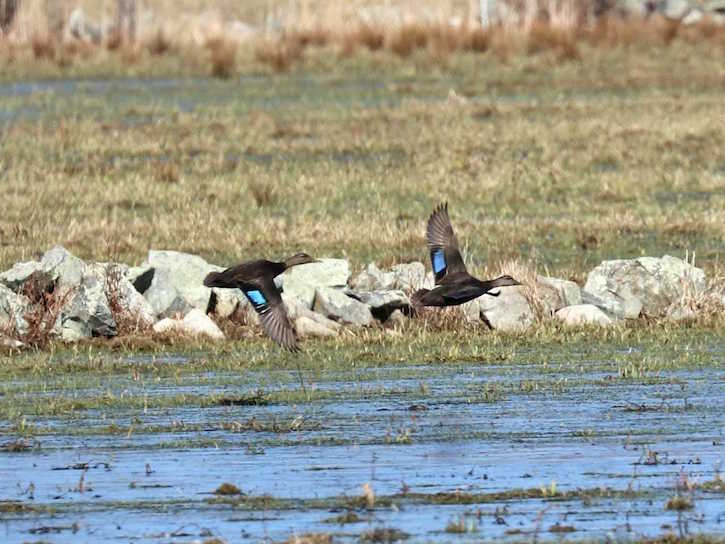
In the fields on our way to Plum Island, we passed flocks of American Robins, who have announced spring to most people, regardless of their ornithological acumen. Three Turkey Vultures soared over Route 1, near where a kettle formed most afternoons throughout the winter. The non-migration of the TVs says “climate change” to us. They always moved in and out of Pennsylvania when I was growing up, but now they stay there along with Black Vultures, a few of which wintered even in Massachusetts this year.
At parking lot #1, where we made only a brief stop for the facilities, we searched for adult Bald Eagles that have been seen sitting in a pair on one of the Osprey platforms in the marsh. We didn’t see them, but a House Finch sang forcefully from the gatehouse. American Black Ducks and Canada Geese were all over the marsh for now, as the duckiest month approaches. At the Main Panne, American Black Ducks predominated, but there was a good gathering of eight Gadwalls and a pair of American Wigeons. An American Goldfinch “potato-chipped” behind us, reminding me of how few of them have been around this winter. Red-winged Blackbirds are arrayed up and down the island now; we were still enjoying how their intense calling fill us with the sense of spring.
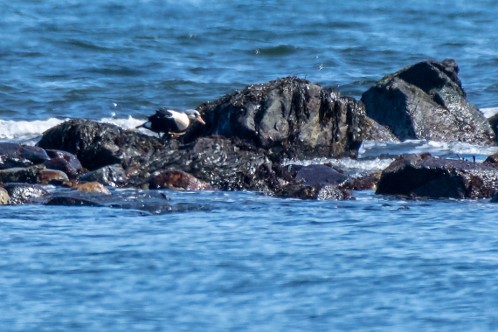
At Emerson Rocks, off of the parking lot #7 dune platform, we hoped to see a lot of things, including Piping Plovers that were spotted by Stan Deutsch in a pre-WMB scouting run. Alas, they must have moved on, though we know they are hanging out at Sandy Point. We did have a good selection of wintering, or now migrating, sea ducks. American Goldeneyes, Long-tailed Ducks, Common Eiders, and Black and White-winged Scoters crowded around the rocks. The latter scoters were much less abundant, but a Horned Grebe beginning to transition into alternate plumage had us studying that look in the field guide. The sub-adult male King Eider that has stolen the show all winter was still there; we hope he comes back next year sporting a fully mature, bright bill!
We had passed some Ring-necked Ducks on Stage Island Pool on our way south, so we stopped in to enjoy them on our return trip. They were very close to the road, and as we watched, some of us saw an American Coot come out and disappear around the corner of a spit of reeds. Off in the distance, a raptor (which eventually resolved, in the light-distorting air, to be a Rough-legged Hawk) perched in a thin line of trees. It was a great day in the Great Marsh and inland, presaging a month when the excitement of the neotropical migration builds. We hope you will join us to witness it!
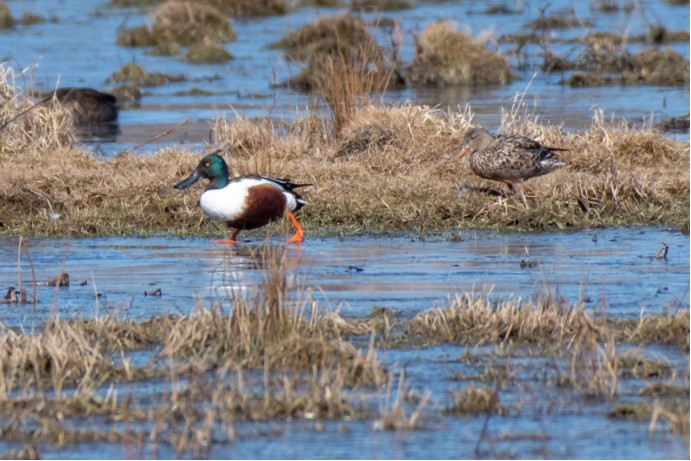
Our list:
Scotland Road and along the way:
Canada Goose – common.
American Black Duck (2) – Common Pasture.
Mallard – common.
Northern Shoveler (2) – Common Pasture.
Green-winged Teal (~30) – Common Pasture.
Rock Pigeon (~15) – various.
Killdeer (8) – Common Pasture.
Turkey Vulture (3) Near Rt. 1.
Red-tailed Hawk (2) various.
American Crow (2) – Common Pasture.
Common Raven (2) – Common Pasture.
American Robin – common.
House Sparrow (4) – Common Pasture.
Song Sparrow – common.
Red-winged Blackbird – common.
Plum Island:
Brant (~20) – Bar Head.
Canada Goose – common.
Mute Swan (2) – South Pannes.Gadwall (8) – Main Panne.
American Wigeon (2) – Main Panne.
American Black Duck – common
Mallard – common
Ring-necked Duck (9) – Stage Island Pool.
King Eider (1) – Emerson Rocks.
Common Eider – common.
White-winged Scoter (3) – Emerson Rocks.
Black Scoter (~50) – Emerson Rocks.
Long-tailed Duck (~10) – Emerson Rocks.
Bufflehead (2) – Bar Head.
Common Goldeneye (~10) – Emerson Rocks.
Red-breasted Merganser (2) – Plumbush River.
Horned Grebe (1) – Emerson Rocks.
American Coot (1) – Stage Island Pool.
Herring Gull – common.
Osprey (1) – Pools near Wardens.
Northern Harrier (3) – North Field.
Rough-legged Hawk (1) – Trees beyond Stage Island Pool.
Black-capped Chickadee (1) – parking lot #1.
American Robin (4) – various.
Northern Mockingbird (1) – parking lot #7 thicket.
Song Sparrow – common.
Red-winged Blackbird – common.
Common Grackle (~15) – parking lot #1.
House Finch (1) Gatehouse.
American Goldfinch (1) behind Main Panne.

